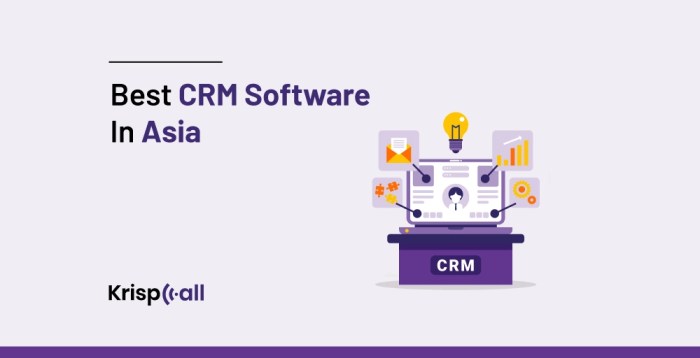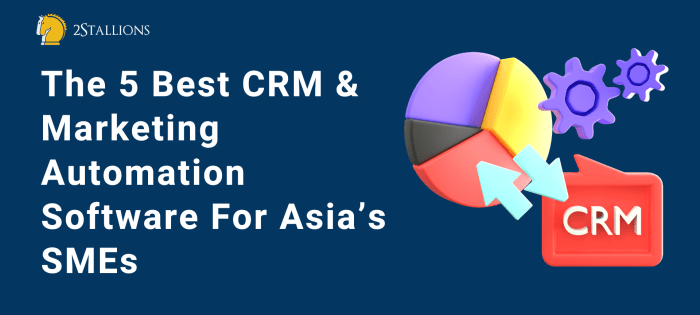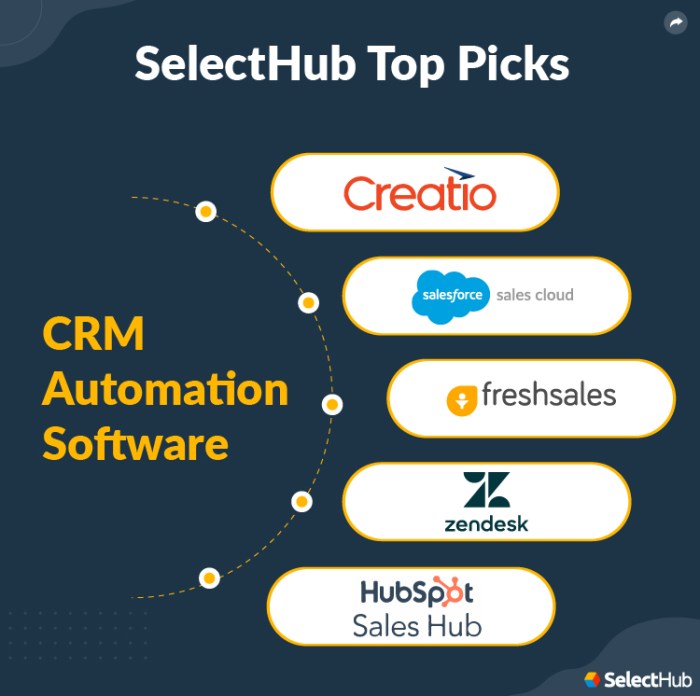Best CRM software with automation features are revolutionizing how businesses manage customer relationships and streamline operations. This exploration delves into the criteria for selecting the ideal CRM, examining key automation features, popular platforms, and the challenges and future trends shaping this dynamic landscape. We’ll uncover how the right CRM can significantly boost efficiency, improve customer experiences, and ultimately drive business growth.
The journey will cover everything from choosing the right features to implementing and integrating the system effectively.
Understanding the nuances of CRM automation is critical for modern businesses. From marketing campaigns to sales processes and customer support, automation streamlines workflows, enhances efficiency, and frees up valuable time for strategic initiatives. This guide will equip you with the knowledge to choose, implement, and optimize a CRM system that aligns perfectly with your business needs and objectives, ensuring a smoother, more efficient operation.
Defining “Best” CRM Software: Best CRM Software With Automation Features
Selecting the “best” CRM software hinges on aligning its features with specific business needs and priorities. A CRM deemed optimal for one company might be inadequate for another. Therefore, a robust evaluation process, emphasizing automation capabilities, is crucial. This section details the criteria for assessing CRM effectiveness, the importance of scalability and adaptability, and a proposed scoring system for ranking CRM software based on its automation features.
Criteria for Evaluating CRM Software Effectiveness, Best CRM software with automation features
The effectiveness of a CRM system, particularly its automation features, can be measured across several key areas. The following table provides a structured overview of these criteria, their importance, measurement methods, and illustrative examples.
| Feature | Importance | Measurement | Example |
|---|---|---|---|
| Automation Capabilities | High | Number of automated processes, efficiency gains | Automated lead assignment, email marketing campaigns |
| Integration with other tools | High | Number of integrations, ease of use | Seamless integration with marketing automation platforms, email clients |
| User-friendliness | Medium | User training time, satisfaction surveys | Intuitive interface, easy navigation |
| Scalability and Adaptability | High | Ability to handle increasing data volume, flexibility in customization | System can handle a tenfold increase in leads without performance issues |
| Reporting and Analytics | Medium | Quality of reports, ease of data analysis | Detailed sales reports, customizable dashboards |
| Security and Compliance | High | Security certifications, data encryption | Compliance with GDPR, SOC 2 certification |
Importance of Scalability and Adaptability
Scalability and adaptability are paramount in a CRM system, especially when considering automation. As a business grows, its data volume and automation needs will inevitably increase. A scalable CRM can efficiently handle this growth without performance degradation. Adaptability ensures the system can be customized to accommodate evolving business processes and automation requirements. For example, a CRM initially used for sales automation might need to integrate marketing automation or customer service features as the company expands.
Lack of scalability and adaptability can lead to system bottlenecks, inefficiencies, and ultimately, hinder business growth.
CRM Software Scoring System
A scoring system can provide a structured approach to ranking CRM software based on automation features. Each feature can be assigned a weight based on its importance, and a rating (e.g., 1-5) reflecting its effectiveness in the CRM system. The weighted average score provides a comparative ranking. For example: Lead scoring automation (weight: 0.25, rating: 4), email marketing automation (weight: 0.2, rating: 5), sales process automation (weight: 0.25, rating: 3), customer service automation (weight: 0.3, rating: 4).
This results in a weighted average score of 3.85. This scoring system facilitates objective comparison and selection of CRM software.
Key Automation Features in CRM Software
Several essential automation features significantly enhance CRM effectiveness. These features streamline workflows, improve efficiency, and enhance customer interactions. The following section details five key automation features and explores the implementation of automation across marketing, sales, and customer service.
Five Essential Automation Features
- Lead Scoring and Qualification: Automatically assigns scores to leads based on pre-defined criteria (e.g., website activity, engagement), prioritizing high-potential leads for sales follow-up. This improves sales efficiency by focusing on qualified leads.
- Email Marketing Automation: Automates email campaigns, including triggered emails based on user behavior (e.g., abandoned cart emails). This increases engagement and improves conversion rates.
- Sales Process Automation: Automates tasks like lead assignment, follow-up reminders, and opportunity tracking. This frees up sales representatives to focus on relationship building and closing deals.
- Customer Service Automation: Automates responses to frequently asked questions (FAQs) through chatbots and knowledge bases. This improves response times and frees up customer service agents to handle complex issues.
- Reporting and Analytics Automation: Automates the generation of reports and dashboards, providing real-time insights into sales performance, customer behavior, and other key metrics. This facilitates data-driven decision-making.
Comparison of Automation Implementations
Marketing automation focuses on nurturing leads and driving conversions through automated email campaigns, social media engagement, and other marketing activities. Sales automation streamlines the sales process, automating tasks like lead qualification, follow-up, and opportunity management. Customer service automation improves response times and customer satisfaction through automated responses, chatbots, and knowledge bases. While distinct, these automation types are often integrated within a single CRM system, creating a cohesive customer journey.
Workflow of a Typical Automated Process
The following flowchart illustrates the workflow of a typical automated process, such as lead nurturing, within a CRM system:
1. Lead Capture: A potential customer submits a form or interacts with a website.
2. Lead Scoring: The CRM automatically assigns a score to the lead based on predefined criteria.
3.
Lead Qualification: Leads exceeding a certain score are automatically qualified.
4. Automated Email Sequence: A series of automated emails is triggered, providing information and nurturing the lead.
5. Sales Follow-up: A sales representative is notified and follows up with the qualified lead.
6. Opportunity Management: The opportunity is tracked within the CRM, and further automation steps are triggered based on progress.
7. Reporting and Analytics: The effectiveness of the automated process is tracked and analyzed.
Popular CRM Software with Robust Automation
Several leading CRM platforms offer robust automation capabilities. This section compares three popular CRMs and explores niche CRM systems designed for specific industries. The integration capabilities of these systems with other business tools are also discussed.
Comparison of Leading CRM Platforms

| CRM Name | Key Automation Features | Pricing Model | User Reviews Summary |
|---|---|---|---|
| Salesforce | Sales Cloud, Service Cloud, Marketing Cloud, various integrations | Subscription-based, tiered pricing | Generally positive, but some users find it complex and expensive. |
| HubSpot | Marketing automation, sales automation, service automation, CRM platform | Freemium model, various paid tiers | Positive reviews for ease of use and comprehensive features, particularly for marketing. |
| Zoho CRM | Sales automation, marketing automation, customer service automation, various integrations | Subscription-based, tiered pricing | Generally positive for affordability and wide range of features. Some users mention limitations compared to Salesforce or HubSpot. |
Niche CRM Systems

Several niche CRM systems cater to specific industries with tailored automation features. For example, a healthcare CRM might automate patient appointment scheduling and medication reminders, while a real estate CRM could automate property listing updates and client communication. These specialized systems offer automation features optimized for the unique workflows and requirements of their respective industries.
Integration Capabilities
Popular CRM systems typically offer robust integration capabilities with other business tools, including marketing platforms (e.g., Mailchimp, Marketo), email providers (e.g., Gmail, Outlook), and other applications. These integrations streamline workflows by enabling data synchronization and automation across various platforms. For instance, integrating a CRM with a marketing automation platform allows for automated lead nurturing based on website activity tracked by the marketing platform.
This seamless data flow eliminates manual data entry and ensures consistency across different business tools.
Implementation and Integration Challenges
Implementing a CRM system with automation features presents several challenges. This section discusses common challenges, provides a step-by-step integration guide, and offers a troubleshooting guide for common issues.
Common Implementation Challenges
Common challenges include data migration issues, resistance to change from employees, inadequate training, and insufficient planning. Data migration requires careful planning and execution to ensure data accuracy and completeness. Employee resistance can be addressed through effective communication and training. Insufficient planning can lead to unforeseen problems and delays. Addressing these challenges proactively is crucial for successful CRM implementation.
Step-by-Step Integration Guide
- Assessment: Evaluate current business processes and identify areas for automation.
- Selection: Choose a CRM system that aligns with business needs and integrates with existing tools.
- Planning: Develop a detailed implementation plan, including timelines, responsibilities, and resources.
- Data Migration: Migrate data from existing systems to the new CRM, ensuring data accuracy and consistency.
- Configuration: Configure the CRM system to match business processes and automation requirements.
- Testing: Thoroughly test the system to identify and resolve any issues before full deployment.
- Training: Provide comprehensive training to employees on using the new CRM system.
- Deployment: Deploy the CRM system and monitor its performance.
- Optimization: Continuously optimize the system based on user feedback and performance data.
Troubleshooting Guide
Common issues include integration problems, data inconsistencies, and user errors. Troubleshooting steps typically involve checking system logs, verifying data integrity, and reviewing user configurations. Detailed documentation and support resources are crucial for effective troubleshooting.
Future Trends in CRM Automation
The future of CRM automation is marked by the increasing adoption of AI-powered features and predictive analytics. This section explores these trends and their potential impact on business efficiency and customer experience.
Emerging Trends
AI-powered features, such as intelligent chatbots and predictive lead scoring, are transforming CRM automation. Predictive analytics provides insights into customer behavior, enabling proactive engagement and personalized experiences. For example, a CRM system might predict which customers are likely to churn, allowing for proactive intervention to retain them. The use of machine learning for automating complex tasks, such as lead prioritization and customer segmentation, is also gaining traction.
Impact on Business Efficiency and Customer Experience
These trends are expected to significantly improve business efficiency by automating repetitive tasks and providing data-driven insights. Enhanced customer experience is achieved through personalized interactions, proactive support, and improved response times. For example, AI-powered chatbots can provide instant support, while predictive analytics can enable personalized marketing campaigns. The result is a more efficient and customer-centric business operation.
Anticipated Evolution of CRM Automation
Over the next five years, we anticipate a significant increase in the adoption of AI-powered features and predictive analytics within CRM systems. The integration of these technologies will lead to more sophisticated automation capabilities, enabling hyper-personalization and proactive engagement. We expect to see a shift from rule-based automation to AI-driven automation, with a focus on improving both business efficiency and customer experience.
This evolution will result in more intelligent, adaptive, and customer-centric CRM systems that learn and evolve with the business.
Final Conclusion

Ultimately, selecting the best CRM software with automation features requires careful consideration of your specific business needs, budget, and long-term goals. By understanding the key features, popular platforms, and potential challenges, you can make an informed decision that will empower your team, enhance customer relationships, and propel your business toward greater success. The future of CRM automation is bright, promising even greater efficiencies and improved customer experiences through AI and predictive analytics.
Embrace the power of automation to transform your business.
Helpful Answers
What is the average cost of CRM software with automation features?
Pricing varies greatly depending on the features, number of users, and vendor. Expect to find options ranging from free plans with limited functionality to enterprise-level solutions costing thousands of dollars per month.
How long does it typically take to implement a new CRM system?
Implementation timelines vary widely based on the complexity of the system, the size of your business, and your existing infrastructure. Simple implementations might take a few weeks, while more complex projects could extend to several months.
What are the common signs that my business needs a CRM with automation?
Signs include repetitive manual tasks, difficulty tracking customer interactions, inconsistent communication, and a lack of sales/marketing data analysis.
Can I integrate my existing software with a new CRM system?
Most modern CRM systems offer robust integration capabilities with popular business tools. However, the ease and complexity of integration will vary depending on the specific software involved.
